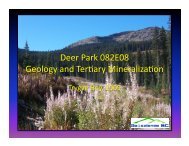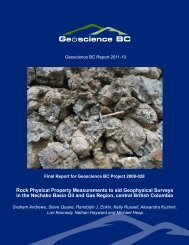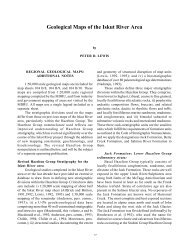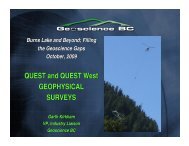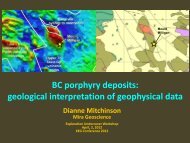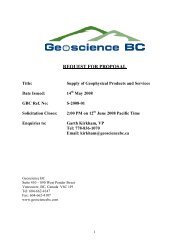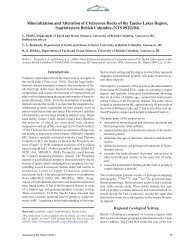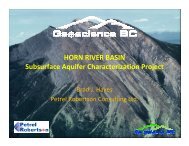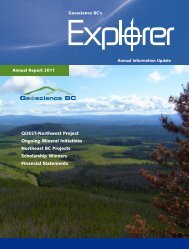Final Report - Geoscience BC
Final Report - Geoscience BC
Final Report - Geoscience BC
Create successful ePaper yourself
Turn your PDF publications into a flip-book with our unique Google optimized e-Paper software.
4. RPDS Application4.1. General OverviewRPDS is designed to act as an integration platform to combine geophysical and geological datain order to effectively query rock property statistics for specific rock types across geographicareas. This allows for answering questions such as: What is the average density of basalts in theChilcotin area? or what is the average resistivity of a rhyolite in a VMS-type deposit? Thesetypes of questions are answered in RPDS by distillation of the large amount of data intomanageable, interpretable, queryable data tables. Figure 3 illustrates this distillation processshowing physical property logs for a theoretical borehole at depth including the associatedlithology, formation, and alteration information. Firstly, RPDS creates “geologic intervals” forcommon occurrences of lithology, formation, and alteration type (a geologic signature). Forexample, the first geologic interval is L1-F1-A1, the second is L2-F1-A2, and so on. Thisprocess is repeated at depth along the hole for each change in one of the geological variables.Then, for each interval, the physical property parameters are combined, calculating populationstatistics for that specific geological signature at that depth. The next phase of data distillationcombines each common interval, for example, all intervals with an L2-F1-A2 geologic signature(yellow zones on Figure 3) are combined, further summarizing the data. Next, the areaclassification (Country-Province-Area-Deposit) of each borehole is assessed and physicalproperties for all common geologic intervals across all holes within the same geographic area arecombined. Therefore physical properties of rocks with L2-F1-A2 signatures in the Sudburydeposit will not be combined with those having the same L2-F1-A2 signature in the Sullivandeposit. <strong>Final</strong>ly, this information is combined with the sample data having the same geologicalsignature for the same area. Therefore, all occurrences of L2-F1-A2 in any borehole or samplewithin the Bowser basin area in British Columbia are combined, providing, for example, onemean density value for a Sandstone with Argillic Alteration from the Brothers Peak Formationin the Bowser Basin area.12





